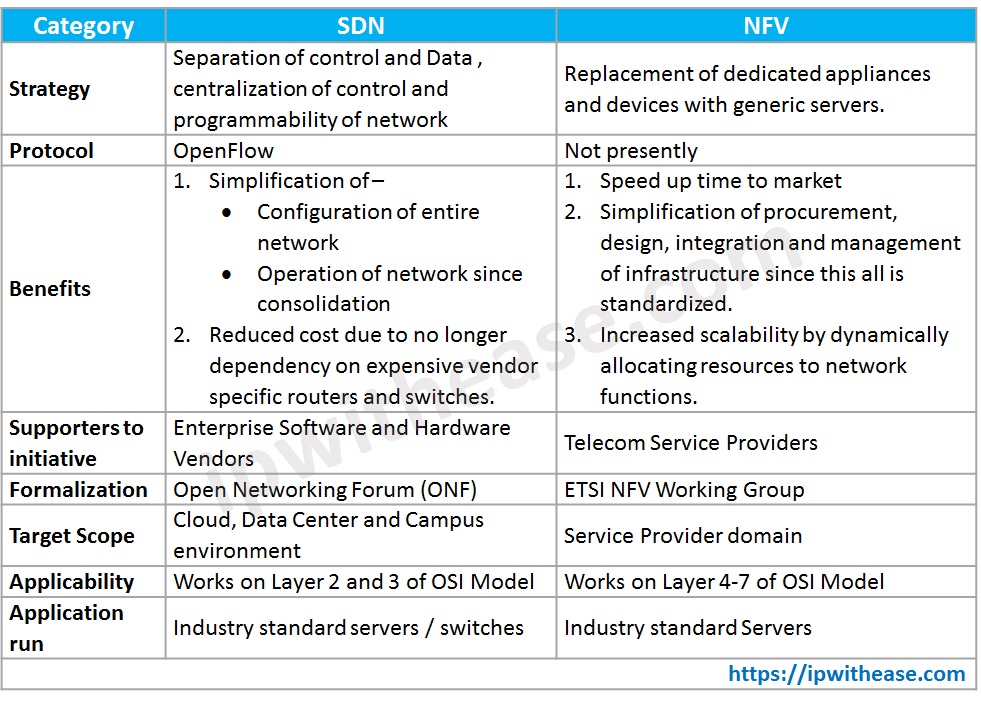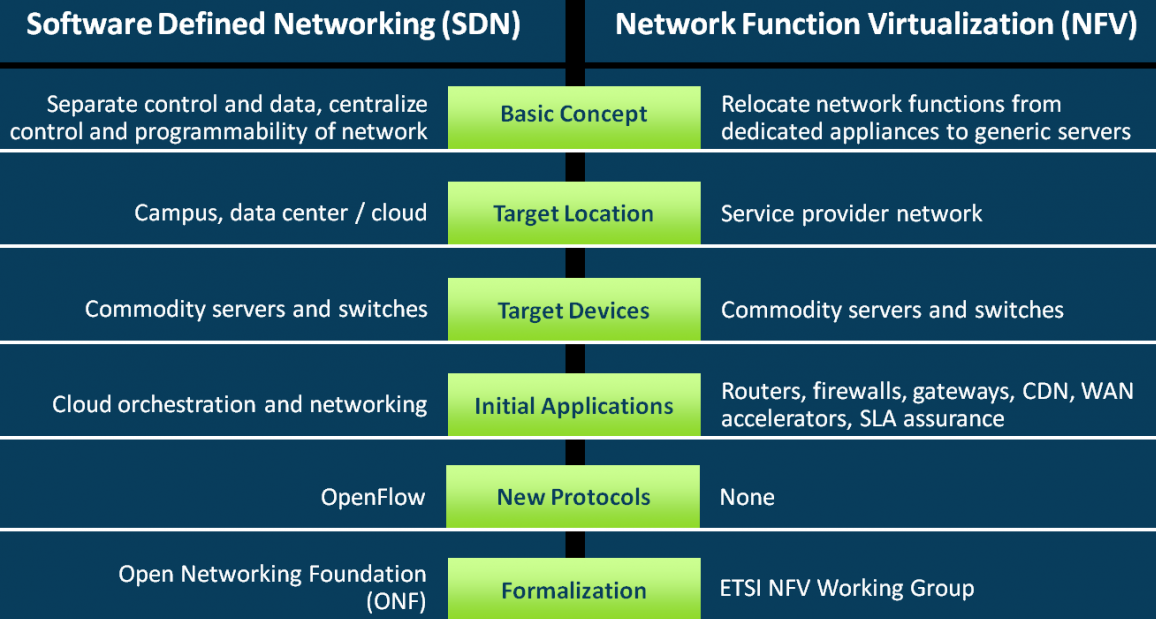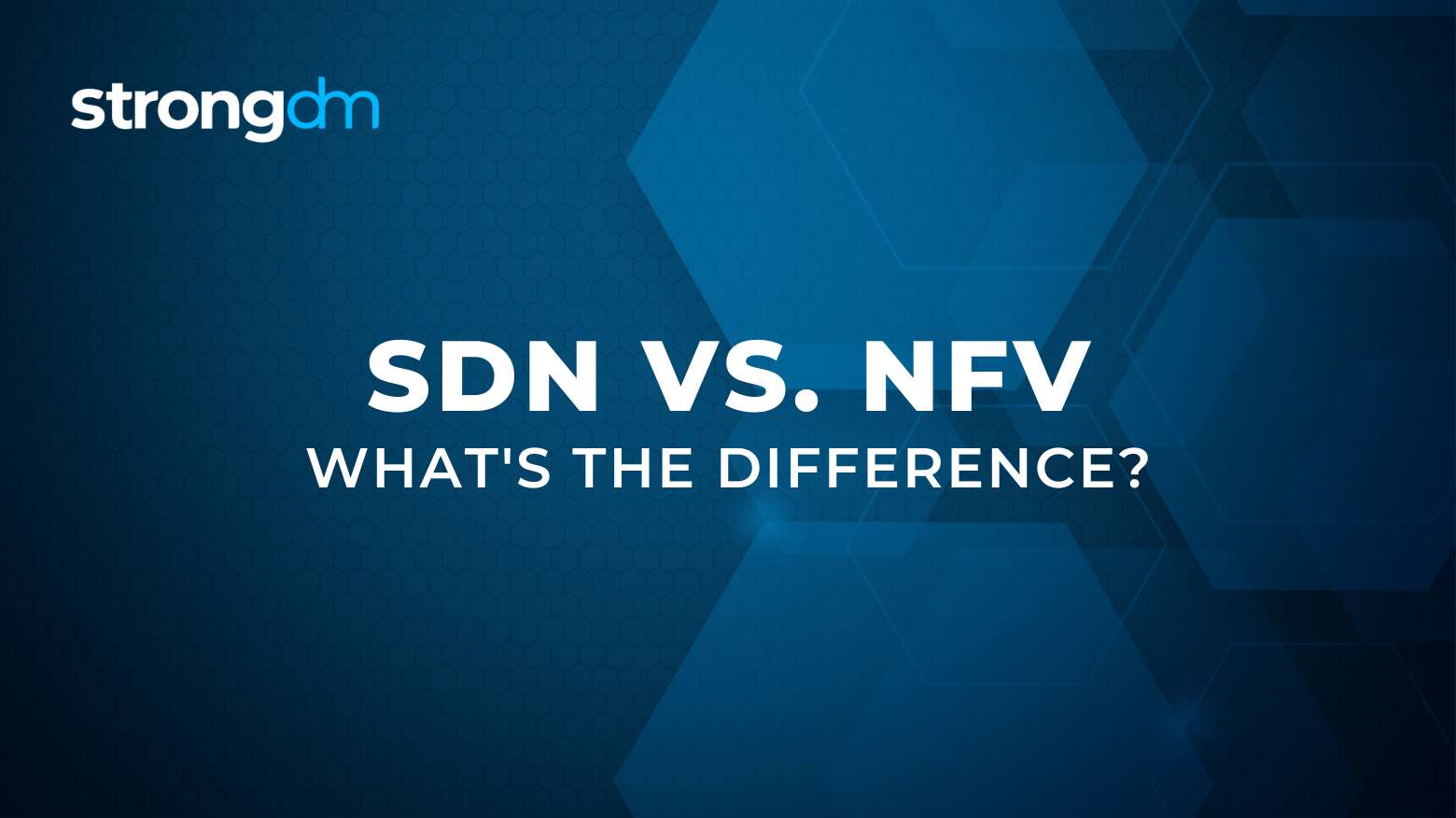Antwort What is the difference between SDN and NFV? Weitere Antworten – What are the differences between NFV and SDN

SDN is mainly used in data center or campus networks for centralized control, while NFV is often used in WANs to reduce physical device needs. While both SDN and NFV aim to improve network efficiency and reduce costs, they differ in architecture, deployment scenarios, and management requirements.Key differences between NFV and NV
NFV is concerned with virtualising network functions, whereas NV is concerned with virtualising network infrastructure. NFV promotes agility and cost-effectiveness while NV improves the overall network efficiency and security.SDN attempts to isolate network control operations from network forwarding services. In contrast, NV attempts to abstract network forwarding and other networking functions from the hardware on which they execute. As a result, both rely on virtualization to abstract network architecture and infrastructure in software.

What is SDN and VNF : NFV architecture allows SDN functions to become fully realized, adopted and optimized within the network. Virtual network functions (VNFs) build off of the parent architecture of NFV. This allows IT organizations to consume network services on generic hardware, sometimes referred to as a CPE or uCPE provider.
Which is better SDN or NFV
NFV provides the basic networking functions and SDN assumes higher-level management responsibility to orchestrate overall network operations. SDN and NFV have much in common, based on the concept of virtualization that drives the development and deployment of their capabilities.
What are the principles of SDN and NFV : SDN decouples the data and controls network traffic control planes, making the control and routing of network traffic more flexible and efficient. NFV decouples network functions from specific hardware platforms via virtualization to make the provision of these functions more efficient and flexible.
Network Function Virtualization (NFV) is a concept closely-related to software defined networking (SDN) whereby certain aspects of network operations (routing for example) are de-coupled from hardware and delivered as a software-only product or service.

Example – Microsoft SWAN
Microsoft has developed a range of software-defined networking (SDN) technologies to optimally manage routing and centralize control of its network. The company's network is built with standard switches and routers, which Microsoft manages with its own software.
What is SDN and how it works
What is Software-Defined Networking (SDN) Software-Defined Networking (SDN) is an approach to networking that uses software-based controllers or application programming interfaces (APIs) to communicate with underlying hardware infrastructure and direct traffic on a network.In many ways, SDN and NFV are interdependent. When deployed together, they can achieve flexible, agile network infrastructures. NFV provides the basic networking functions and SDN assumes higher-level management responsibility to orchestrate overall network operations.Benefits of Software-Defined Networking (SDN)
SDN allows data to move easily between distributed locations, which is critical for cloud applications. Additionally, SDN supports moving workloads around a network quickly.
Network function virtualization disadvantages
Exposes the network to new types of attacks because it can't be protected by physical security control like with traditional networking. Malware can spread more easily among components because they all run on the same virtual machine.
Can SDN and NFV work together : SDN and NFV technologies are complementary
One of the key elements that facilitate SDN adoption is the growing use of network functions virtualization. SDN and NFV technologies are complementary, with NFV providing many of the actual services managed in a software-defined network.
Where is SDN used : What are some of the main uses for SDN Software-defined networks are increasingly used in large data centers. A data center is a collection of servers and networking equipment, typically within a single building, which stores, processes, and exchanges data.
Is SDN still used
SDN is still nascent, and the technology has been applied primarily to cloud-hosted control planes implemented in production networks. But the industry is now beginning to apply SDN to access networks and programmable pipelines used to deliver new data plane features.

Putting SDN and NFV together
SDN separates the control plane from the forwarding plane, and NFV decouples network functions from vendor hardware. SDN and NFV offer different approaches to flexible, scalable, elastic, and agile network deployment.Software-defined networking (SDN) is an architecture that abstracts different, distinguishable layers of a network to make networks agile and flexible. The goal of SDN is to improve network control by enabling enterprises and service providers to respond quickly to changing business requirements.
How is NFV related to SDN : SDN allows networks to be centrally controlled via software applications that use open APIs. While NFV divides the network functions from the hardware components so that they can run in software.
